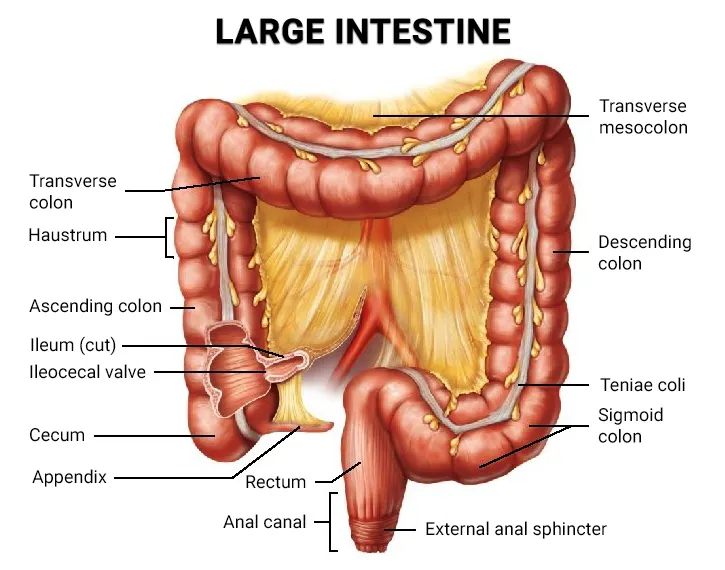Gain a comprehensive understanding of the large intestine through our detailed overview, encompassing its parts, functions, illustrative diagrams, and other key details.
Digestion is like the body’s way of turning complicated food into simpler forms that our blood can soak up and carry everywhere. This whole digestion thing not only gives us energy but also helps our cells do their job of keeping us alive. Picture it as a long tube called the alimentary canal, starting from the mouth and going all the way down to the large intestine. It’s a food journey through our body!
Size and Length of Large Intestine
This part of our body is known as the large intestine because it is wider than the small intestine but is considerably shorter.
The human large intestine, also known as the colon, has an average length of 5 feet (1.5 meters) in adults. However, it’s important to remember that individual variations are quite common, and the actual length can range from:
- 4 feet (1.2 meters) to 6 feet (1.8 meters) for males
- 3.5 feet (1.1 meters) to 5.5 feet (1.7 meters) for females
The large intestine is around 5 feet long, while the small intestine is much longer, measuring approximately 21 feet. The final 6 inches or so of the large intestine are referred to as the rectum and the anal canal.
Learn More About Small Intestine
Large Intestine Parts
It is a combination of the cecum, colon, rectum, and anal canal. The colon is the largest portion of the large intestine. It is divided into five sections:
- Ascending
- Transverse
- Descending
- Sigmoid
- Rectum

Egested Waste
The rectum is the final holding place for waste in our body. After the small intestine has done its job with the undigested and unabsorbed food, it passes on to the large intestine. Here, the large intestine absorbs all the water from the remaining food, turning it into a semi-solid substance. This semi-solid food takes a pit stop in the rectum for a while before being expelled from the body as faeces. This whole process of getting rid of waste is called egestion or defecation. It’s the body’s way of saying goodbye to stuff it doesn’t need!
The function of the Large Intestine
The large intestine, or the colon, is vital to your digestive system. It’s about 5 feet long and 6 inches wide and in your abdomen. The large intestine has several important functions, including:
- Absorption of water and electrolytes: The large intestine absorbs about 90% of the water and electrolytes not absorbed in the small intestine. This helps to solidify stool and prevent dehydration.
- Formation of stool: The large intestine mixes undigested food with mucus and bacteria to form stool.
- Storage of faecal matter: The large intestine stores stool until it is ready to be eliminated.
- Production of vitamins: The bacteria in the large intestine produce some vitamins, such as vitamin K and biotin.
- Protection against harmful bacteria: The bacteria in the large intestine help to keep harmful bacteria in check.
The large intestine is an important part of your digestive system and plays a role in many bodily functions. It’s important to keep your large intestine healthy by eating a balanced diet, exercising regularly, and staying hydrated.
Also Read: 8 Key Differences between Small Intestine and Large Intestine
Can You Live Without Your Large Intestine?
Yes, you can survive without your large intestine. It might sound surprising, but it’s true. The large intestine mainly absorbs water and electrolytes to concentrate stool. While it helps with bowel movements, it doesn’t play a huge role in metabolism. People can lead perfectly normal lives without it.
To Know more about electrolytes read this Healthline Article on electrolytes
The large intestine guides waste to the rectum, which is then expelled during a bowel movement. However, the large intestine can sometimes develop issues like diverticulitis, cancer, or benign polyps, which are often discovered during a colonoscopy. Additionally, the appendix, part of the colon, might need to be removed if inflamed.
In the case of these diseases, the whole large intestine might need to be removed. When that happens, it’s replaced with a pouch made from the small intestine and stitched to the anus.
Frequently Asked Questions on Large intestine.
Passing gas, or flatulence, happens when we swallow air or eat foods that are hard to digest. For instance, foods like beans contain raffinose, which causes bacteria in our intestines to break down, releasing gas and causing flatulence. It’s just a natural part of how our bodies process certain foods!
Eating a diet low in fibre and high in fat, leading a sedentary lifestyle, and indulging in alcohol and smoking are all factors connected to colorectal cancer. These habits can contribute to the development of this type of cancer.
The appendix is a small, vestigial organ attached to the large intestine. When it gets inflamed, a condition called appendicitis, the only solution is to remove the appendix.
The human large intestine, also known as the colon, has an average length of 5 feet (1.5 meters) in adults.
The large intestine mainly absorbs water, electrolytes, and vitamins while forming and storing the stool.
You May Like:

